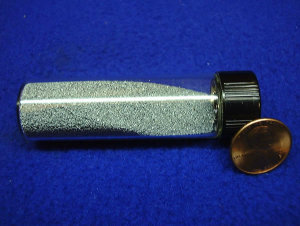![]() The Pacific War Online Encyclopedia
The Pacific War Online Encyclopedia
|
| Previous: Tungchingcheng | Table of Contents | Next: Tunhua |

U.S. Geological Survey. Via Wikimedia
Commons
Tungsten, element number 74, is a scarce heavy metal characterized by its extremely high melting point of 6192 °F (3422 °C), greater than any other pure element. Its Brinnel hardness of 2570 is much greater than that of even the hardest steel armor plate, but tungsten is brittle and would be unsuitable for structural use even if it were not so expensive. In 1959, it cost almost a dollar per pound.
Tungsten is used in filaments for light bulbs and other instruments and was a vital alloying element for producing high temperature steels for machine tools and advanced aircraft engines (particularly turbocharger blades.) Steel alloyed with tungsten retains a very high hardness at elevated temperatures. Tungsten carbide is even harder at high temperature than the metal and is used much like diamond as an embedded abrasive in drill bits.
Large reserves of tungsten were located in China, which was the world's
leading
producer in the early 20th century and remains so today.
Production was severely hindered by the
war, dropping from 16,500 tons in 1937 to 9000 tons in 1943. Most
of
this production was exported to the United States and Britain as partial
repayment
for pre-Lend-Lease loans to
the
Chinese government, as well as to Russia
for its earlier military assistance.
Significant
deposits were also being mined in Burma
and Malaya, in the western
United
States,
and in Tasmania, as
well as in South America. Small deposits were found in Japan and Korea,
but these were inadequate for
the Japanese wartime economy, and this contributed to a shortage
of
machine
tools and high-temperature alloys for aircraft after
the
American submarine
blockade cut
Japan off from her supplies in southeast Asia. This was
fortunate
for the Allies, as the
Japanese had produced some excellent aircraft designs by 1945, but
these
required tungsten alloys that were no longer available.
Tungsten was a limiting resource even for the Allies, in spite of their access to much greater reserves, since its availability limited how many high-performance aircraft engines could be produced. There was something of a tungsten rush in the western United States from 1941 on, with numerous amateur prospectors seeking promising deposits using mail-order fluorescent lamps. These produced a brilliant glow from scheelite, the principal ore mineral. Prospectors who "struck it rich" found their claims mapped by government geologists at public expense, and then usually sold their claims to established mining companies.
Mawchi
Salmon
San Bernardino
Sariwon
Storey's Creek
References
U.S. Geological Survey (accessed 29 December 2006)
The Pacific War Online Encyclopedia © 2006-2007, 2009, 2011,2015-2016 by Kent G. Budge. Index